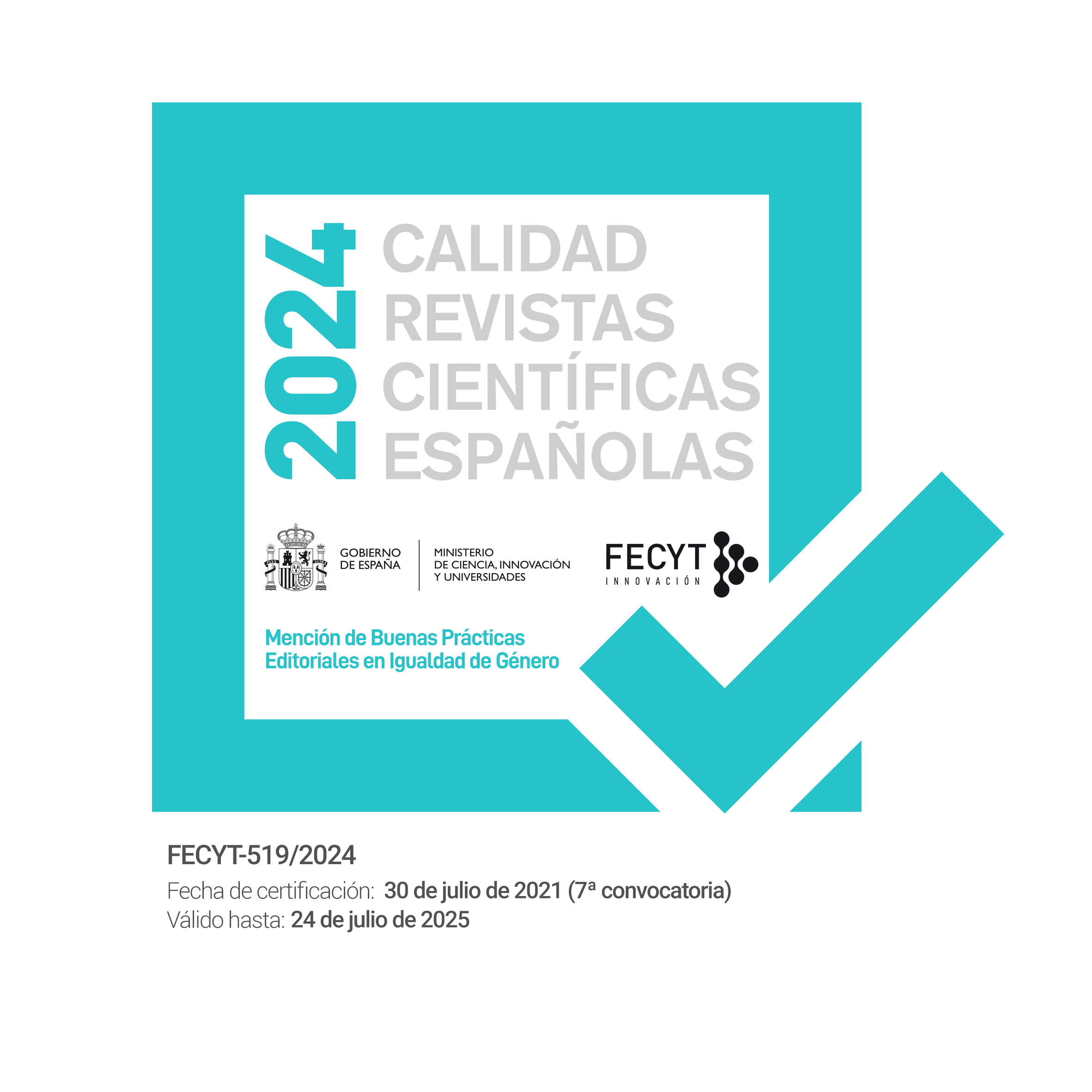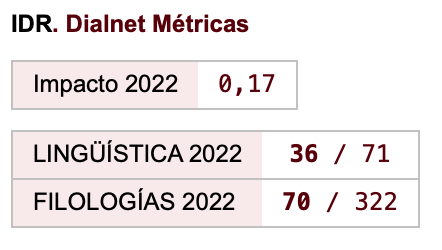Form-Focused Data-Driven Learning for Grammar Development in ESP Contexts
Keywords:
languages for specific purposes, linguistics, applied linguistics, specialised discourse, discourse studies, pragmatics, language teaching, translation, interpreting, English for specific purposes, pedagogyAbstract
The use of corpus-informed language in English for Specific Purposes (ESP) / English for Academic Purposes (EAP) teaching has considerably grown over the past two decades, especially due to the proliferation of course book material based on corpora. However, in terms of learning approaches to grammatical items, much less has been published commercially to train teachers in the use of corpora and their exploitation. DDL (Data-Driven Learning) techniques are still something to foster and publicize for ESP scenarios, since DDL tends to work as a productive method among learners whose L2 courses usually present specific (academic or professional) purposes in language use, as previous studies have shown. This paper deals with DDL as approached via hands-on concordancing by university students in the double degree of Business Administration and Tourism (B/T) in our institution. The targeted linguistic items were accessed via form-focused activities (e.g., noticing usage differences with verb tenses and synonymous verbs). Two grammar tests were administered to compare their results with another group that focused on the same grammatical points as delivered by an upper-intermediate, corpus-informed, textbook. The statistical findings reveal that the DDL group performed slightly better in the acquisition of such grammatical points, whereas most students felt that lexico-grammatical knowledge had been gained by relying on DDL to discover and apply usage patterns. Grammatical study may thereby evolve as a different perception in their minds due to corpus data exploitation and teacher-mediated discovery.Downloads
References
Aston, G. (1997). Small and large corpora in language learning. In B. Lewandowska-Tomaszczyk & P. Melia (Eds.), Practical applications in language corpora (PALC 97) (pp. 51-62). Lodz: Lodz University Press.
Aston, G. (Ed.) (2001). Learning with corpora. Houston: Athelstan.
Baker, M., Francis, G., & Tognini-Bonelli, E. (Eds.) (1993). Text and technology. Amsterdam: John Benjamins.
Bernardini, S. (2001). Corpora in the classroom: An overview and some reflections on future developments. In J. Sinclair (Ed.), How to use corpora in language teaching (pp. 15-36). Amsterdam: John Benjamins.
Boulton, A. (2009). Data-driven learning: Reasonable fears and rational reassurance. Indian Journal of Applied Linguistics, 35(1), 1-25.
Boulton, A. (2010). Data-driven learning: Taking the computer out of the equation. Language Learning, 60(3), 534–572.
Boulton, A. (2012). Corpus consultation in ESP: a review of empirical research. In A. Boulton, S. Carter-Thomas & E. Rowley-Jolivet (Eds.), Corpus-informed research and teaching in ESP (pp. 261-292). Amsterdam: John Benjamins.
Charles, M. (2011). Using hands-on concordancing to teach rhetorical functions: Evaluation and implications for EAP writing classes. In A. Frankenberg-Garcia, L. Flowerdew & G. Aston (Eds.), New trends in corpora and language learning (pp. 26-43). London: Continuum.
Charles, M. (2015). Same task, different corpus: The role of personal corpora in EAP classes. In A. Lenko-Szymanska & A. Boulton (Eds.), Multiple affordances of language corpora for data-driven learning (pp. 131-154). Amsterdam: John Benjamins.
Cheng, W., Warren, M., & Xun-feng, X. (2003). The language learner as language researcher: Putting corpus linguistics on the timetable. System, 31(2), 173–186.
Chujo, K., Oghighian, K., & Akasegawa, S. (2015). A corpus and grammatical browsing system for remedial EFL learners. In A. Lenko-Szymanska & A. Boulton (Eds.), Multiple affordances of language corpora for data-driven learning (pp. 109-130). Amsterdam: John Benjamins.
Council of Europe. (2003). Common European framework of reference for languages. Cambridge: Cambridge University Press.
Curado-Fuentes, A. (2007a). Digital reading strategies in computer science. Revista Alicantina de Estudios Ingleses, 20(1), 23-43.
Curado-Fuentes, A. (2007b). A corpus-based assessment of reading comprehension in English. In E. Hidalgo, L. Quereda & J. Santana (Eds.), Corpora in the foreign language classroom (pp. 309–326). Amsterdam: Rodopi.
Curado-Fuentes, A. (2015). Exploiting keywords in a DDL approach to the comprehension of news texts by lower-level learners. In A. Lenko-Szymanska & A. Boulton (Eds.), Multiple affordances of language corpora for data-driven learning (pp. 176-194). Amsterdam: John Benjamins.
Curado-Fuentes, A. (2016). Grammatical development via DDL at the upper-intermediate level in LSP contexts. In M.F. Litzer, J. García-Laborda & C. Tejedor-Martínez (Eds.), Beyond the universe of languages for specific purposes: The 21st century perspective (pp. 65-68). Alcalá de Henares: Universidad de Alcalá, Servicio de Publicaciones.
Davies, Mark. (2008-). The corpus of contemporary American English: 520 million words, 1990-present. <http://corpus.byu.edu/coca/> [20/2/2017]
Flowerdew, L. (2001). The exploitation of small learner corpora in EAP materials design. In M. Ghadessy, A. Henry & R. Roseberry (Eds.), Small corpus studies and ELT: Theory and practice (pp. 363-379). Amsterdam: John Benjamins.
Flowerdew, L. (2008). Pedagogic value of corpora: A critical evaluation. In A. Frankenberg-Garcia (Ed.), Proceedings of the 8th teaching and language corpora conference (pp. 115-119). Lisbon: AEICI.
Frankenberg-Garcia, A. (2014). The use of corpus examples for language comprehension and production. ReCALL, 26(2), 128-146.
Gairns, R. & S. Redman. (2012). Natural English upper-intermediate. Oxford: Oxford University Press.
Gavioli, L. (2006). Exploring corpora for ESP learning. Amsterdam: John Benjamins.
Gavioli, L. (2009). Corpus analysis and the achievement of learner autonomy in interaction. In L. Lombardo (Ed.), Using corpora to learn about language and discourse (pp. 39–72). Bern: Peter Lang.
Hoey, M. (1991). Patterns of lexis in text. Oxford: Oxford University Press.
Hoey, M. (2005). Lexical priming: A new theory of words and language. London: Routledge.
Huang, Z. (2014). The effects of paper-based DDL on the acquisition of lexico-grammatical patterns in L2 writing. ReCALL, 26 (2), 163-183.
Hunston, S. (2002). Corpora in applied linguistics. Cambridge: Cambridge University Press.
Hunston, S., & Francis, G. (2000). Pattern grammar. A corpus-driven approach to the lexical grammar of English. Amsterdam: John Benjamins.
Johns, T. (1988). Whence and whither classroom concordancing? In P. Bongaerts, P. de Haan, S. Lobbe & H. Wekker (Eds.), Computer applications in language learning (pp. 9-27). Dordrecht: Foris.
Johns, T. (2002). Data-driven learning: The perpetual challenge. In B. Kettemann & G. Marko (Eds.), Teaching and learning by doing corpus analysis (pp. 107-118). Amsterdam: Rodopi.
Lenko-Szymanska, A., & Boulton, A. (Eds.) (2015). Multiple affordances of language corpora for data-driven learning. Amsterdam: John Benjamins.
Mauranen, A. (2004). Spoken corpus for an ordinary learner. In J. Sinclair (Ed.), How to use corpora in language teaching (pp. 89-105). Amsterdam: John Benjamins.
Milton, J. (1996). Exploiting L1 and L2 corpora for computer assisted language learning design: The role of an interactive hyptertext grammar. In S. Botley, J. Glass, A. McEnery & A. Wilson (Eds.), Proceedings of teaching and language corpora (pp. 233-243). Lancaster: Lancaster University.
Nassaji, H. (2000). Towards Integrating form-focused instruction and communicative interaction in the second language classroom: Some pedagogical possibilities. The Modern Language Journal, 84(2), 241-250.
O’Keefee, A., McCarthy, M., & Carter, R. (2007). From corpus to classroom: Language use and language teaching. Cambridge: Cambridge University Press.
Pashler, H. McDaniel, M., Rohrer, D., & Bjork, R. (2008). Learning styles: Concepts and evidence. Psychological Science in the Public Interest, a Journal of the Association for Psychological Science, 9(3), 103-119.
Pérez-Basanta, C. (2005). Assessing the receptive vocabulary of Spanish students of English philology: An empirical investigation. In E. Martínez-Dueñas (Ed.), Towards an understanding of the English language, past, present and future: Studies in honour of Fernando Serrano (pp. 545–564). Granada: Universidad de Granada.
Pérez-Paredes, P., & Cantos-Gómez, P. (2004). Some lessons students learn: Self-discovery and corpora. In G. Aston, S. Bernardini & D. Stewart (Eds.), Corpora and language learners (pp. 247-257). Amsterdam: John Benjamins.
Robinson, P. (1995). Attention, memory, and the noticing hypothesis. Language Learning, 45(1), 283-331.
Scott, M., & Tribble, C. (2006). Textual patterns: Key words and corpus analysis in language education. Amsterdam: John Benjamins.
Seidhofer, B. (2000). Operationalizing intertextuality: Using learner corpora for learning. In L. Burnard & T. McEnery (Eds.), Rethinking language pedagogy from a corpus perspective (pp. 207-223). Frankfurt: Peter Lang.
Skehan, P. (2001). The role of a focus on form during task-based instruction. In C. Muñoz-Lahoz, M.L. Celaya-Villanueva, M. Fernández-Villanueva, T. Navés & O. Struck (Eds.), Trabajos en lingüística aplicada (pp. 11-24). Barcelona: Univerbook.
Smart, J. (2014). The role of guided induction in paper-based data-driven learning. ReCALL, 26 (2), 184-201.
Thomas, J. (2015). Stealing a march on collocation: Deriving extended collocations from full text for student analysis and synthesis. In A. Lenko-Szymanska & A. Boulton (Eds.), Multiple affordances of language corpora for data-driven learning (pp. 85-108). Amsterdam: John Benjamins.
Williams, J. (2001). The effectiveness of spontaneous attention to form. System, 29(4), 325-340.
Witten, I.H., Wu, S., Franken, M., Brine, J., Brown, K., & Fitzgerald, A. (2015). FLAX: Flexible language acquisition. <http://flax.nzdl.org/greenstone3/flax?a=fp&sa=library> [8/31/2016].
Downloads
Published
How to Cite
Issue
Section
License
Authors who publish with this journal agree to the following terms:
- Authors retain copyright and grant the journal right of first publication with the work simultaneously licensed under a Creative Commons Attribution License that allows others to share the work with an acknowledgement of the work's authorship and initial publication in this journal.
- Authors are able to enter into separate, additional contractual arrangements for the non-exclusive distribution of the journal's published version of the work (e.g., post it to an institutional repository or publish it in a book), with an acknowledgement of its initial publication in this journal.
- Authors are permitted and encouraged to post their work online (e.g., in institutional repositories or on their website) prior to and during the submission process, as it can lead to productive exchanges, as well as earlier and greater citation of published work (See The Effect of Open Access).

Revista de Lenguas para fines específicos is licensed under a Creative Commons Reconocimiento-NoComercial-SinObraDerivada 4.0 Internacional License.























